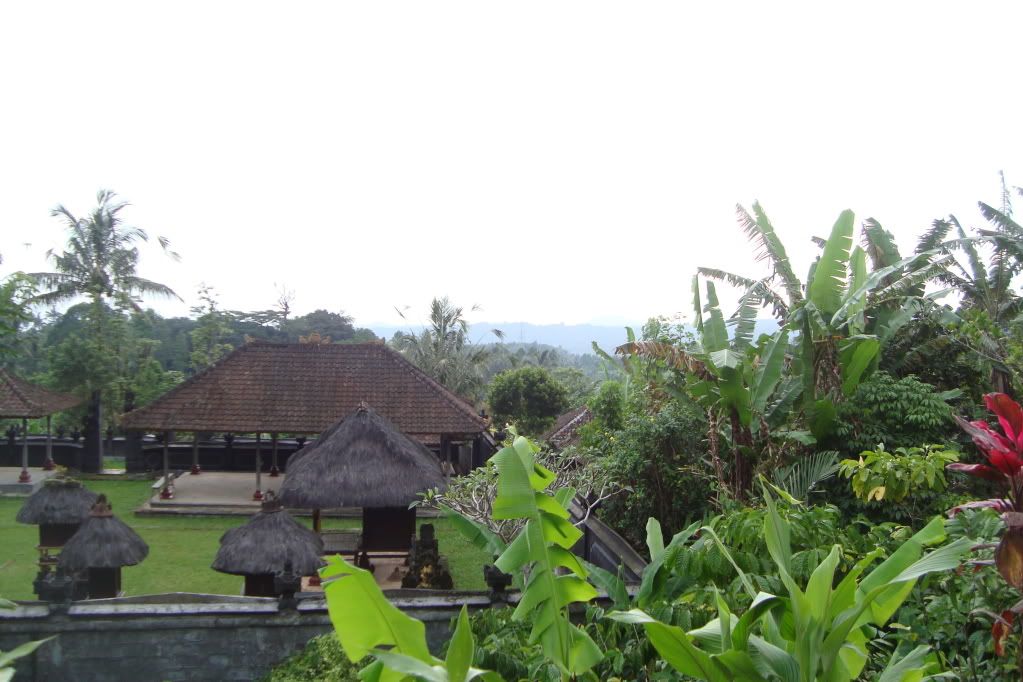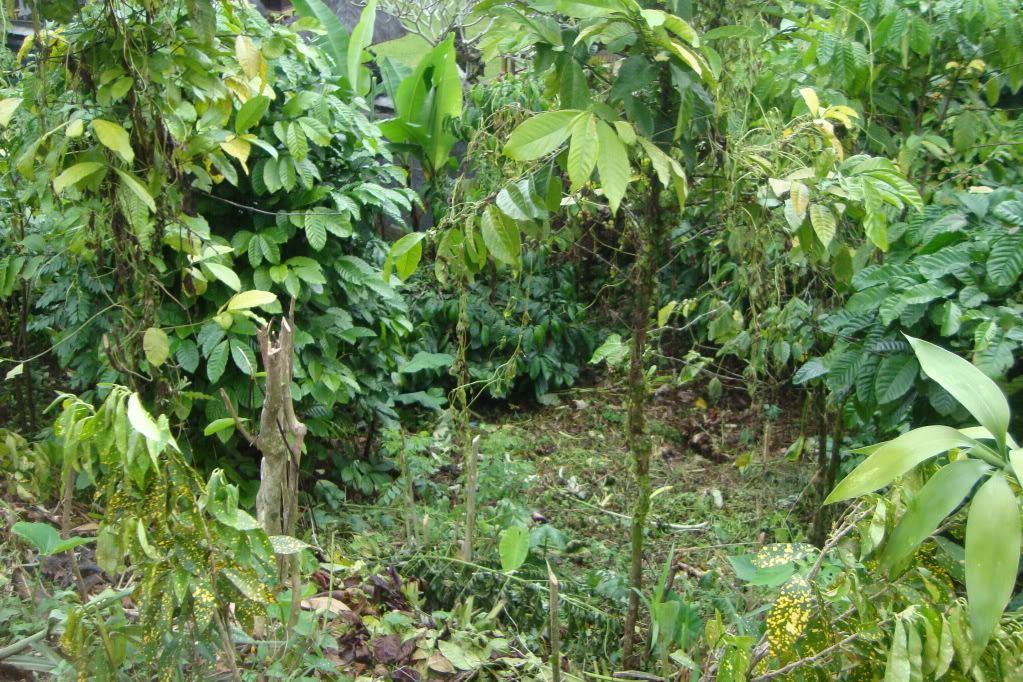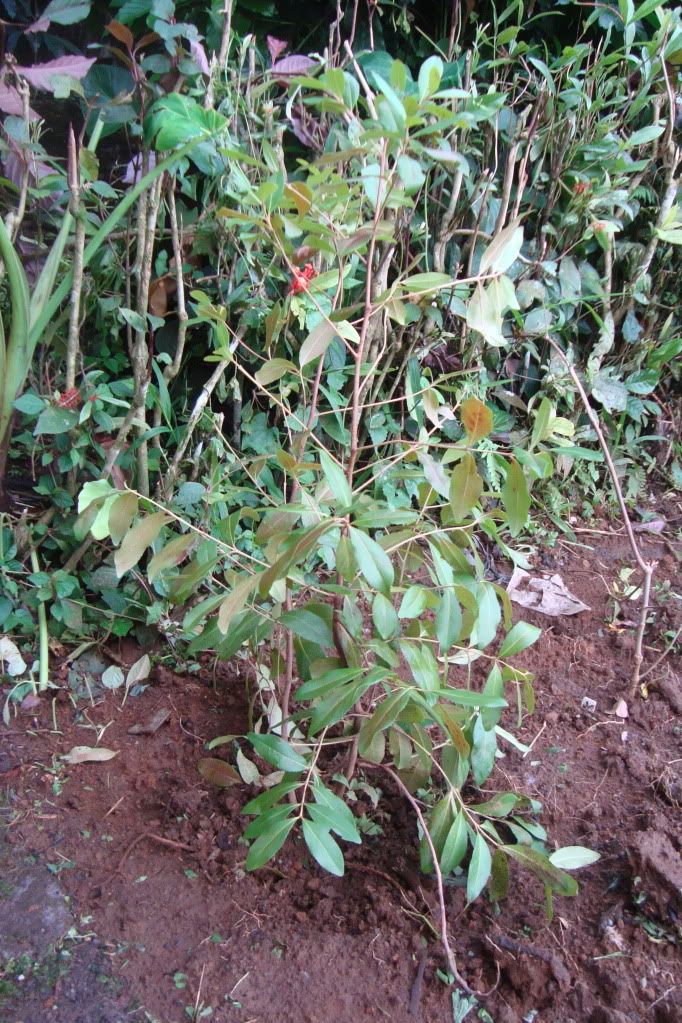A Garden in Bali Part 1
Up in the mountains of Bali are a number of sleepy villages nestled among the mixed Clove, coffee and chocolate forests. They are mostly enclaves of traditional balinese religion and culture where the economy is largely based on a subsistence horticulture incorporating wet rice fields (Sawah), home Gardens (Pekarangan), Mixed gardens (Kebun) and Agroforestry (Talun). These systems support local livestock industries of suckling pigs, Balinese cattle, Village chickens and Goats. Ducks are also sometimes raised in stalls
Cashflow comes from excess rice, Coconuts, Coffee, Clove and other spice crops, Chocolate. Fruit crops also contribute income and Citrus and Durian are important cash crops, followed by Salak and Mangosteen.
The climate is milder at altitude and the rainfall is high. Placed on the slopes of an extinct volcano the soils are rich and well textured and the peaks are still covered in cloud forest.
I was presented with the opportunity to partner with a balinese friend to buy a small house in one of these villages. At the end of an alley looking out across coconuts and temples all the way to the ocean, and on a clear day beyond to the East coast of Java, the worlds most populous island.
 |
| Fresh air and Inspiring views from the front doorstep |
The house is small, just 6 x 9 metres in total, on a level land parcel of 200m2 constructed of blocks made of volcanic tuff and cement, lined with woods harvested from local agroforests, and roofed with locally made clay tiles. 2 bedrooms, lounge and a central thoroughfare. Kitchen and bathroom to one side.
The Roof was leaking and termites had caused a collapse in the kitchen. The roof was Asbestos sheeting. I could see this was no quick fix! but i bought in anyway..The prospect of a retreat in such a beautiful place with such peace and safety was too much to pass up. And then of course was the possibility to build a garden! Climates and soils like this in Australia are extremely rare and priced at a premium, id never get this chance at home!
Repairs began soon. All the roof sheeting was removed carefully and placed aside, the timbers were all removed and burned and replaced with New timbers. Local woods were sourced such as old coconut for the doorways, old coconut has a beautiful grain, Dark and speckled. An Albizzia species was used as battens. Some mahogany forms secondary support and a third unidentified wood with a rich red colour not unlike true american mahogany forms the main beams. In time i will plant replacement timbers on adjacent land to replace all wood in the house when the time comes with timber of higher quality, but thats another blog to write up!
The roof went on in January consisting of a good quality fired terracotta tile manufactured near tabanan. Tiles need to be carefully selected and painted with a waterproof paint before being laid. The higher quality the tile the better waterproofing ability and longer life of the support timbers and furniture below! heavy rain and ceremonial duties delayed the roof but this is expected in any building project.
Work like this is very cheap compared to Australia and the aesthetic outcome is unparalelled. It is my intention to restore this old girl to a condition higher than its original and retrofit it with some appropriate technologies that improve comfort while fitting seamlessly with the local traditional and emerging local style.
 |
| A local House, newly built, showing the design and aesthetic common for local buildings for those with the means to do so. The design incorporates Cultural and practical design for this very Humid but sometimes cool climate. |
Work continues on restoration, time was needed to ensure the roof did not leak and allow all timbers and walls to dry out thoroughly after being exposed to rain. It was lucky i took this go slow approach as the roof does leak in places. A loose tile and improperly sealed tiles are the causes and are being rectified with adjustmnet and a second coat of waterproofing paint.
 |
| Flat tiles and capping tiles were given one coat of a waterproofing paint. This should last 6 to 10 years. One coat proved insufficient and a second coat was applied and which accomplished the main goal of a sealed roof :) |
 |
| The Roof headpiece was selected by my good brother, I Wayan Joni. In Hindu tradition the Ancient Swastika symbol is associated with good luck and wellbeing. It is related to the traditional balinese greeting, Om Swasti Astu - meaning may the divine grant you health and wellbeing. |
The next tasks will be the internal and external rendering of the block walls using sand and cement. There needed to be an adjusting of door heights upwards 20cm to accomodate my taller frame, and that of the average European male. From my short travels in Java i noticed the Balinese to be a taller and more robust people, and im sure a few of them would also hit their heads on the original doorways! The next step will be the fitting of new internal and external doors, nice and sturdy and made of all local materials that support growers and crafts people to maintain their skills. Finally we will be completing the ceramic tiling throughout the house. Its practicality to tile in this terrain, the red volcanic earth is most easily washed from a sealed hard surface. Mould is controlled by admitting UV light via glass tiles, by ventilation and by the used of clove oil in washing walls, an all natural strategy!
 |
| The original interior showing tiled floors, hardwood window frames, Open vents above windows and rendered walls. The darkness has been adjusted by installing a glass tile to admit light, and while vents will remain open i will be fitting a fine "midge" grade insect gauze screen to fit in the recess so allowing air but not insect movement! |
Retrofitting for environmental health and comfort will include replacing some clay tiles with clear or frosted glass tiles, and some bricks with glass bricks to remove the need for use of electric light during the day. Fortunately a government susbisdized scheme is underway in the local area to supply power to these houses with 900W power supply. This will allow use of LED lighting, a low wattage refrigeration unit, ceiling fan and charge points for Radio, battery lamps, mobile phones and laptops. Hot water will be an imported continuous supply Gas unit, no storage tank, fitted to LPG. The tap water itself is supplied from the higher slopes of the volcano and is clean not requiring treatment, like the air up there it is crisp and pure.
 |
| The exposed bathroom after roof removal. The cistern overflowing due to leak is fixed, its called a Mandi and water is bucketed from it to wash or flush using a ladle. The Asian style squat toilet is very healthy and easy to adjust to. A shower head and wash basin will be installed fitted to an instantaneous gas water heater from the kitchen. The window filled with opaque glass bricks and the walls rendered, surfaces tiled... and a towel rack in there too ;) |
With the frequency of heavy cloud cover solar power is not an option. The area has a lot of potential for village scale small hydroelectric, and the region has untapped geothermal reserves. A small locally manufactured solar water heater could be built if cheap enough to justify its infrequent use. Perhaps a chip heater using small locally abundant and available agricultural waste would be most appropriate. Biogas or syngas are other options, and these are things i will try in future once all other household economies are brought to full efficency.
 |
Original state
|
 |
Roof approaching restoration..
|
When the time comes ill fit the house with furniture garnished from local bamboo villages that make beds and other items from domestic bamboo, and from shops that sell recycled furniture, hopefully i can hold out for antiques.. Old teak and other wooden items from colonial and later 20th century styles.
So with the house gradually regaining livability my attention turns to the garden, the icing on the cake..and we all really know its the card that draws me!
My Garden
Situated in an area that is a classic example of Indonesias home gardens and complex agroforests it is paradise for an enthusiast and ethnobotanist like myself. The surrounding farms consist of shade grown Balinese Robusta coffee, of which i have been shown at least 3 distinct varieties. Among this are stands of Cacao for chocolate, Javanese and Cassia cinnamon, Nutmegs, Cloves, Vanilla, Citrus, Mangosteen, Durian, Salak palm, Coconut and numerous other minor cash and susbsistence species. A full inventory has not been made but it is a task i will relish.
 |
| Rich soils support Healthy coffee plantations with overstorey of legume shade trees and a herbaceous understory that are trimmed to feed tethered Bali cattle, goats and pigs. Poultry free range in gardens close to the house while further afield roam wildlife including Luwak and Green junglefowl. |
Home gardens are usually seen as stepping off points for the domestication process. Wherever i go keen gardeners will be able to show me plants they have collected in local forests, nearby regions or from their travels of friends far abroad. This village is no different and my friends gardens show all this, with trials and experimnets and horticultural oddities all in varying stages of investigation.
Crime is pretty low level in such a small community, but it does happen. Less likely to be something large or expensive, your car is safe, as are building supplies. When chickens go missing its the talk of the village! But bring a rare plant and it may pay to establish it in a friends home garden first! I know well the allure of a rare or exotic plant, and even the mostly ethical practice of appropriating cuttings can be fatal if the plant is too small and there are too many fingers! Quietly.. this puts a smile on my face :) Ive lived my whole life in societies that treasure a Television, CD's or Bicycles, mass produced short term use throw away items, yet are blind to ethnobotanical value of my amazing plants. Not that anytjing has ever been taken! my friends just warned me as precaution, and i was flattered!! not offended!!
The plant in question is a Javanese medicinal pepper, Red betel (Piper crocatum), one of several Betel peppers and one of the more rare. http://www.sbsymphony.org/2010/03/the-benefits-of-red-betel-leaves/ and http://herbal.medicalonlinemedia.com/2009/09/red-betel-vine-benefit-for-health-beauty/. The Leaves of the Green betel (Piper Betel) along with turmeric and tamarind paste are boiled to make an everyday herbal drink for women that is renowned to maintain and enhance her sexual prowess, especially after childbirth.
 |
| Red betel pepper (Piper crocatum) is a Javanese medicinal species i missed collecting when in Java but managed to locate in bali from a specialist collector at the "exorbitant" price of $AUD 6. It is used in traditional preparations for heart troubles, hypertension, halitosis, diabetes, womens medicine and as an antitussive. |
 |
| Red Betel is sought after as an ornamental in addition to its medicinal value. |
I encourage locals to come and get cuttings. Ill be planting my most useful and rarest indonesian medicinal plants in reach of pathways and i hope people take home seed and cuttings to grow and use.
The garden is to be a launching pad, in the traditional sense, to experimnet with endemic, local, national and international collections of planst useful to the community and the economy. Despite their ecological sustainability the price of rolling out these large scale agroforests is the duplication effect leading to too much coffee, too much chocolate, too much cinnamon. depressed commodity prices, predatory buying practices by middlemen and to top it off disease pressures can lead to a point where it becomes uneconomical to continue.
Balinese landholder have been fortunate that the land prices have skyrocketed in recent years due to interest from developers catering to Villas and tourist markets. Asian investors have also bought in and intensified agriculture of a few species like coffee and citrus. This is often done in a way that destroys the complex fabric of these mixed forests. while outputs of cash commodities increase, the lions share goes offshore while the forest base that sustains the all important non cash economy for locals is eroded. fodder for animals, bamboos and timbers for building are sacrificed for short term gain.
An alternative strategy may be diversification. Because selling your land is a fast track to poverty of future generations and loss of sovereignty. But in the current setting these villages are land rich and cash poor, somethings needs doing. This is an ongoing process and doesn't exclude the growth of short term cash crops. Identifying missed opportunities for specialty timbers, Medicinal and food crops and forage crops is may aim. Co-operation is the key, locals taking care of labour and local ecological knowledge, and foreign partners like myself using our abilities to access planting material from across the globe held in collections or wild sourced, and then to link those products as closely as possible through few hands to the end consumer.
As an Amateur and keen ethnobotanist there is a process of learning where i listen and take in and decode the local understandings , needs and desires, and then try and contribute back to fill in gaps in both education and access to new planting materials. Learning about the cultural and dietary practices of the local area is very rewarding. Locals are always keen to have me try a local speciality, and i always accept. I will cover some of these treats later, wierd and wonderful to outsiders like me, some things i have only read about, and others that come as complete surprise. Local farmers are very competent in their ethnobotanical knowledge of the systems they create and very pleased to engage outsiders who take an interest and can return knowledge.
They are proud of their culture and love to share names and uses, and in return i can more than often tell them of names used by other groups as well as uses they were not aware of. In East java after being shown the traditional rice harvesting process, i reached down and started grazing on a spicy herb from a roadside cut. This immediately interested the villagers who gathered in to see what i was eating, its was
Peperomia pellucida, a crisp and spicy 'weed' that is common across the tropics, and a bane of nurseries as it loves to grow in pots. The locals had no idea it was edible and no name for it, i assured them it was safe, popular in Vietnam, and helped myself to more. An old lady, and then a man jostled through and joined me, tentativetly, in testing this new herb. I told them its good but best mixed, campur, with other greens. Ethnobotany is a 2 way process, first you learn all you can, and the more you know and can share back, the more even the relationship gets and that makes everyone happy!
Ill continue next time looking at the species already in my garden, and those i am collecting for it. Itll be a mix of Balinese, Indonesian and international ethnobotany and a story of how gardeners exchanging information and planting materials across the world is improving the future for everyone.
 |
| Catha edulis Narrow leaf form. Possibly a hybrid of Red and Narrow leaf forms. Intended for use as a hedge. |
,
,























